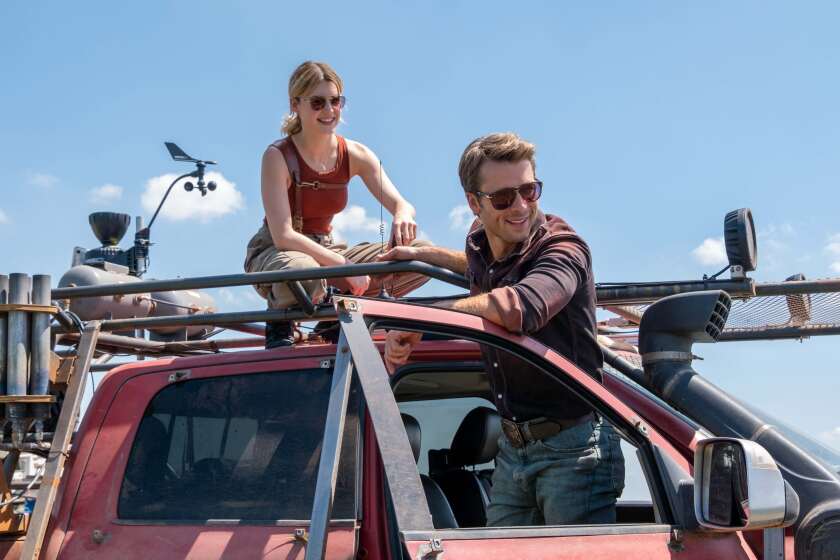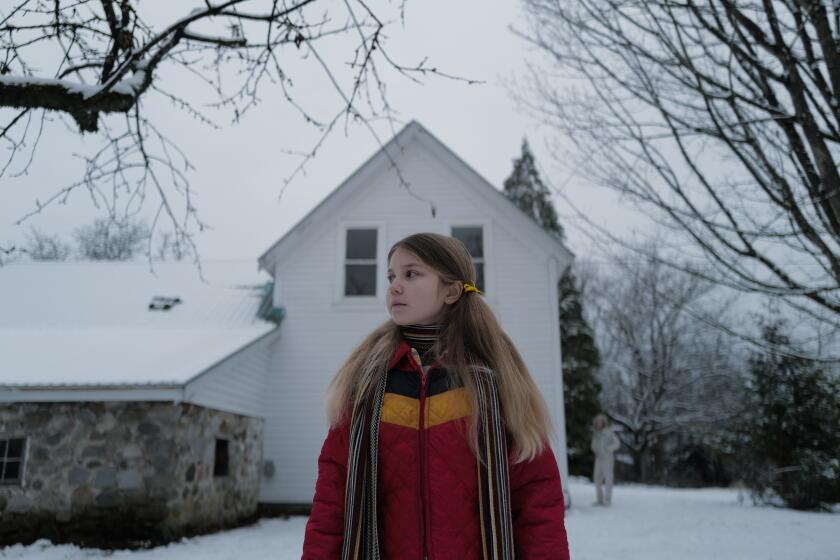A Big Hand for Amelia : Former Actress Enjoys New-Found Fame as Model for Studio’s Logo
Amelia Batchler is especially proud of her hands.
In the 1930s, when they were fair-skinned and unwrinkled, Batchler’s hands were her livelihood. She was a bit-part actress under contract at Columbia Studios, and whenever the script called for a close-up of a woman’s hands, Batchler was called in. Her fingers, her palms, her wrists--but never her face--appeared in feature films with the hands of Cary Grant, Gary Cooper and Fredric March.
“A lot of girls didn’t have pretty hands,” Batchler, now 72, recalled recently. “I had such beautiful hands.”
They earned Batchler a sort of anonymous fame that was to mark her career in Hollywood and they prepared her for the event that would eventually, if oddly, make her a celebrity.
Ordered to Pose for Artist
Around 1933, Columbia Studio boss Harry Cohn ordered her to pose for an Italian artist. Batchler and Columbia officials say the resulting portrait became the studio’s logo, the symbol that has flashed across the screen before every Columbia film for the past 50 years.
It is Batchler standing on that pedestal, swathed in a full-length gown and black velvet wrap, holding aloft a gleaming torch. It is Batchler in the glory of her greatest anonymity.
“I’d like to get a little more credit for it,” she said. “I used to tell people that I was the Columbia logo. But they didn’t care, so I stopped.”
So it is both curious and rewarding to the Bel-Air woman that nostalgia has caught up with her. Now, more than 50 years later, people do care.
Batchler was rediscovered when People magazine was led to her by a nephew. She was featured last February in the magazine’s salute to Hollywood. Soon after, several television networks broadcast her story.
Columbia’s new chairman, David Puttnam, read the People article and wrote to Batchler to say that her portrait has brought “real pleasure . . . to me and everyone who works here.
“Six months ago, I inherited the Harry Cohn ‘hot seat’ and one of the first things that we initiated was a variety of ways of utilizing the original Columbia symbol (you),” Puttnam said in the letter. “During the course of this year a lot will change here at the studio and the one constant factor will be our ever-present logo. I want to make it a source of real pride for the people who work here and, as a result of the movies that it will appear on, a source of pride to you.”
Batchler, who has retained the Texas drawl and blond, curled locks of her youth, is enjoying the delayed acclaim. She laughs when talking about her new-found notoriety, and keeps several copies of the logo in her Mulholland Drive home along with autographed pictures from Ronald and Nancy Reagan, Roy Rogers and the Cisco Kid.
“The funny part of it is, I’ve done so many things since then,” she says of the portrait. “I just don’t understand it.”
Batchler ended her acting career of about five years shortly after posing for the portrait. She said she then became an acting and dialogue coach. The black and white pictures, which she keeps in envelopes and albums, show her on movie sets with actors she claims to have coached, including Jeanette MacDonald, Rita Johnson and Clark Gable.
Claims to Have Saved Judy Garland
Batchler is never in short supply of stories when reminiscing about these times. She claims that while working on the set of the “Wizard of Oz” as a coach, she saved Judy Garland’s life. As Batchler tells it, the young actress, was threatening to fly from the top of a tall ladder. Batchler said she stalled Garland while her husband, actor-producer Keith Daniels, climbed the ladder to grab the actress.
After coaching, she turned to directing. Batchler says she directed some of the first feature films shown in theaters equipped with 16-millimeter projectors, which were also popular for home use. Photographs show the movie posters and cinema marquees advertising the films she directed, such as “Red Star.”
But television and larger cinema screens came along and everyone threw away their 16-millimeter cameras, she says.
Batchler next tried real estate. She still lives on a piece of the 30 acres along Mulholland Drive she and her husband once owned. More recently, she says that she has purchased the rights to a number of William Faulkner works and is transforming them into screenplays. She has also written a full-length animated feature film.
Yet, the story that everyone wants to hear about harks back to the pedestal, the gown and the torch.
Batchler said she had no idea what the portrait was to be used for. She figured it might be a backdrop for a movie being shot on the lot.
“I was about 20 years old and I never asked questions,” she recalled. “They stuck me in this fitting room about 10 by 12 feet, I guess, with no windows. The black velvet was heavy and the artist put some lights on me. Oh, it was hot.
“I posed for three days, eight hours a day. I didn’t know how long he was going to take. Everyday, he said, ‘Tomorrow we’ll do some more.’ When I complained about the heat, the prop man brought a bucket of ice and bottles of Coca-Cola.”
When Batchler’s arm grew tired from holding the torch overhead, the prop man again came to the rescue, hanging the torch from the ceiling by a cable. All that Batchler had to do was hang on.
To the young woman’s surprise, the logo appeared on screen several months later. There were no residuals in those days, so she hasn’t received a cent more than the $75 a week she earned while under contract to the studio.
All that is left to Batchler is a fleeting, recurring moment of glory and an odd sort of fame that fate has allowed her.
More to Read
The biggest entertainment stories
Get our big stories about Hollywood, film, television, music, arts, culture and more right in your inbox as soon as they publish.
You may occasionally receive promotional content from the Los Angeles Times.







